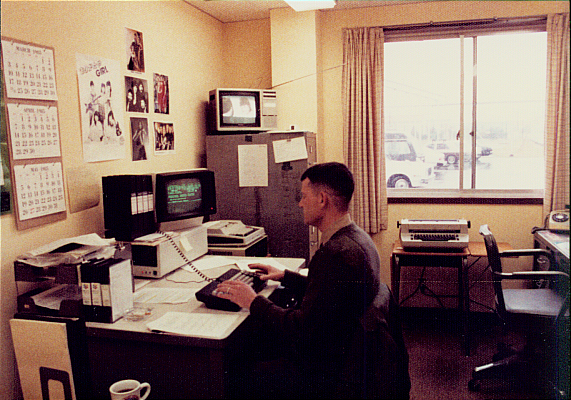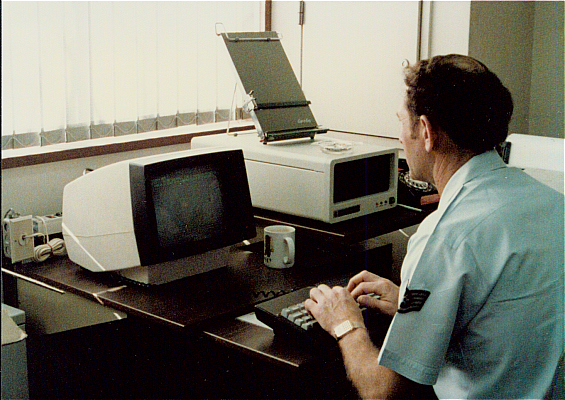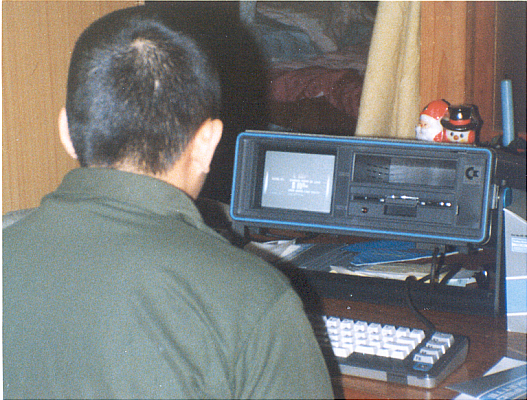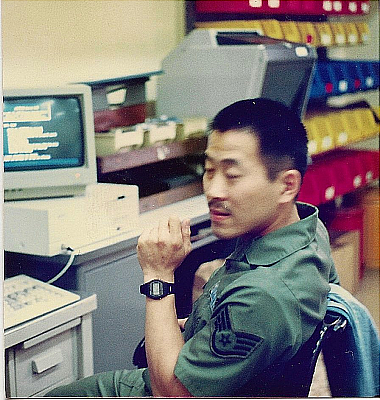Reason for this Website.
Welcome to my new web site, called TheNinjaCodeMonkey.com. I am planning on using this
web site to share my knowledge I obtained over the years in writing computer programs.
My past languages includes, PC assembly, Basic, Fortran, Turbo Pascal, Quick Pascal, C,
C++, and C#
I am a self taught programmer, never took any classes, except for a Java class my employer
sent me along with 5 others. Never did use this language after that week long class.
This web site is a work in progress, so please keep checking back for updates.
December 1982
I started with the Commodore VIC-20 computer in Dec 1982, right before I left for Japan.
I purchased it at the local K-Mart for $99. I was deciding between the Texas Instrument's
TI-99 and the VIC-20. I heard of the VIC-20, so this was my reason for purchasing the VIC-20.
I didn't have any way to save my programs for later retrieval, so if I wanted to mess around
with the same program the next time, I would have to re-key it from scratch. I believe this helped
me in re-coding programs from scratch in my later programming career.
1983

At the AFRTS (Armed Forces Radio Television Station) TV/Radio at Yokota AB, Japan, they had
self built Northstar S-100 computers, running CP/M, with 9" floppy disk drives, 64K of RAM. They
had Asthon-Tate's dBase II as the database engine. I wrote many db2 programs, for keeping up with
inventory of spare part kits for the station.
1984

About this time, a TSgt Gene Parker came up from the FEN station in the Philippines to interface
the IBM Selectric Electric typewriters to the computers using the RS-232C interface. I went about
writing a program to allow the journalists to enter the text to be used on the TV newscast on the
teleprompters. In the past, they would use the typewriters, and had to set their margins, as the
text had to fit within 4" so that the teleprompter camera would pick it up.
I allowed them to save their data in a dBase II database, for later retrieval to be re-used to
edited and printed on a continuous roll of paper.
Personal computers, what we called IBM PC compatiable started coming out in Japan about this time.
A couple of co-workers (SSgt Paul Metzger and IC1 Ray Dye) bought a Sanyo and a NEC IBM PC compatiable
computers for their personal use. Ray who bought the NEC, was in the room next to mine, in the dorms
on base. I would go over to his room, and spent many hours learning to code with a database system
written by Condor. I wrote a movie (VHS tape and Laser Disc) inventory application for his use.
Allowing he to catalog his tape collection, search by title or actor(s).
One time, I remember, he kept asking me what time did I go to sleep. I replied, "When ever
I get tired." Finally, he said, "Dave, I want to go to sleep.", it is 2 in the morning, and we
have to be at work by 6.
1985

In 1985, I ordered the Commodore 64SX, which is their "portable" computer. It comes
with a built in 5" color monitor, a 5-1/4" floppy drive, the lid is the keyboard. The
weight was kind of hefty, so I wouldn't classify it as portable as the laptops of todays
world. It had no built-in battery, so where ever you went, you had to have access to a
110v AC outlet.
1986

Sometime in 1986, I bought a Commodore C-128 computer, with the 640K RAM expansion module,
CP/M and Ashton-Tate's dBase II. With this computer, since I was a secretary of a Men's bowling
league, I wrote a bowling secretary program, to calculate the bowlers averages, print out the
standings sheet, etc. I had a Star Micronics Gemini 10x dot matrix printer, hooked up to the
printer port. I purchased a RGB TV/Monitor from a local store, named Pony's, located right off
base. I never did use the RF modulators on the VIC-20 or C128, I always hooked them up to the
monitor with a self-built RGB cable.
The Air Force started realizing how PC's can assist in doing our every day jobs. So they
shipped a bunch of Sperry PC's to our unit in Japan. I had to go around and add the additional
RAM chips and set them up for the different offices in the station. They was running MS-DOS 2.0,
with a color RGB monitor, 5-1/4" floppy drive, 10 MB hard drive, total RAM 640KB, RBase, WordPerfect,
SuperCalc, to name a few of the applications. I got to learn to program with the RBase database
application.
1987
After I got out of the Air Force on 1 March 1987, I found a job as a computer programmer at a large corporation, Policy Management Systems (PMS). I started on 28 March 1987 as a mid level programmer.
My job was a communication technician, responsible for maintaining all of the communication software and assisting the help desk with any technical assistance with our clients.
With this job, I had some interesting times, helping our clients with their communication and computer problems. One time, I spent over 2 hours on the phone with a client located in Key West, FL. I had to talk her through how to remove the cover off of her IBM XT, remove the communication card, flip a chip around to change the COMM Port from COMM2 to COMM1. She was pleased that she was able to do this task, and that the communcations software started working to be able to download their updates from our servers.
Another time, my predecessor told me as I was taking over his position, he had a client who he had her to place a special order for the serial cable for her modem. I kept wondering and asked him, why a special cable, and why not use a standard cable. He said it wouldn't work. So after about 3 months, this client called me, and ask me to tell her how to install the cable. After talking with her, one end wouldn't fit to the comm port. I asked her to take the cable and plug each end to the other end of the same cable. Wouldn't fit. My predecessor mistakenly had her order the wrong cable, why it took so long to come in. I had her find a standard serial cable, which she had in her office. I had her up and running in a few minutes.